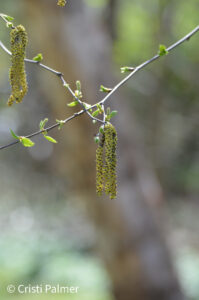Plant Information

Birch trees are deciduous hardwoods that make up the genus Betula, in the Betulaceae family. The genus ranges from 30 to 60 species that are widespread in the northern hemisphere. They are pioneer species, meaning they are the first to colonize open areas, and so they grow quickly and tend to be short-lived.
Birches are small to medium sized trees that can be identified by their bark, which has characteristic horizontal lenticels and often separates into papery plates. Their simple leaves are alternate with serrated margins and are usually a vibrant green that turns a lovely golden yellow in autumn. Their flowers are monoecious catkins that bloom in autumn and persist throughout winter. These catkins provide seeds for birds and squirrels, and many butterflies and moths use birches as host plants.
Generally, birch trees thrive in USDA zones 2 through 9 under full sun and with frequent watering. They prefer cooler climates and may struggle against hot, dry weather. Most birch species prefer moist, acidic, well-drained loams.
Birch species vary in many different colors and uses. Some common North American natives include sweet birch, river birch, and paper birch.
Sweet birch (Betula lenta) gets its common name from the wintergreen smell the inner bark and crushed twigs produce, and it has been used to produce wintergreen oil. It can be identified by its dark gray bark. This bark tends to break into chip-like plates as the tree ages.
River birch (Betula nigra) commonly grows in riverbanks and so it tends to be more culturally adaptable than other birch species. As this tree ages its brown bark peels away, giving an interesting shaggy appearance. Its wood has historically been used for toys and cheap furniture, and the sap can be fermented to make birch beer.
Paper birch (Betula papyrifera) gets its name from its white bark that peels away into papery strips as it ages. This bark has been used to make birch bark canoes. Paper birch is less tolerant of heat than other birch species, so it should not be planted south of USDA zone 7.
Economics
According to the USDA NASS Census of Horticulture, birch sold for a value of $25 million in 2014 and $30 million in 2019.
Main Diseases Problems
Birch trees can suffer from various fungal diseases including anthracnose, cankers, oat root fungus, rusts, sooty mold, and wood decay.
Main Pest Problems
Many insect species target birch trees including aphids, scales, carpenter worms, clearwing moth borers, flatheaded borers, foliage-feeding caterpillars, foliage miners, leafhoppers, sawflies, and lace bugs.
IR-4 Research
IR-4 has conducted 20 crop safety trials on Betula sp., 13 crop safety trials on B. nigra, and 1 crop safety trial on B. papyrifera, to determine if certain pesticide products cause any harm or leave unsightly residues.
Authors
Laura Werner, IR-4 Environmental Horticulture Program Research Assistant
References
https://en.wikipedia.org/wiki/Birch
https://www.gardenia.net/plants/genera/betula-birch/
https://ipm.ucanr.edu/PMG/GARDEN/PLANTS/birch.html
https://portal.ct.gov/CAES/Plant-Pest-Handbook/pphB/Birch-Betula
https://plants.ces.ncsu.edu/plants/betula-lenta/
https://plants.ces.ncsu.edu/plants/betula-nigra/
https://plants.ces.ncsu.edu/plants/betula-papyrifera/
https://quickstats.nass.usda.gov/
